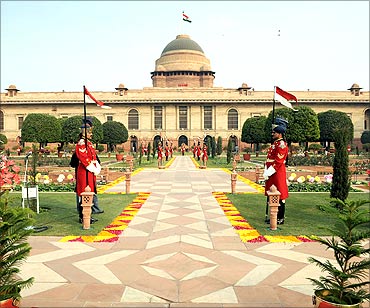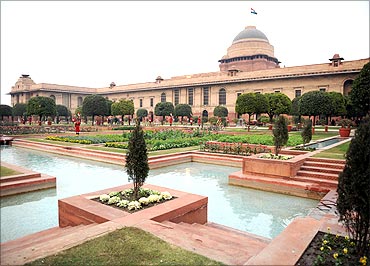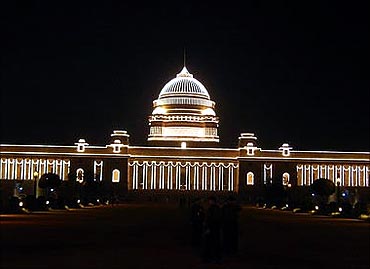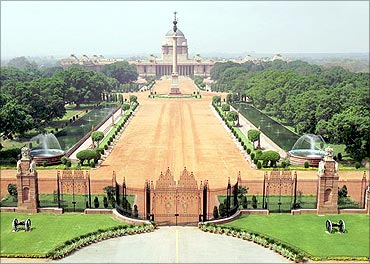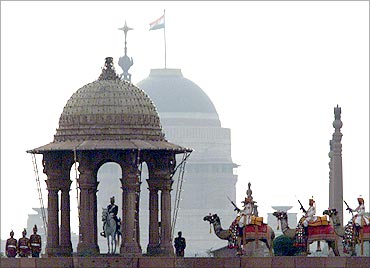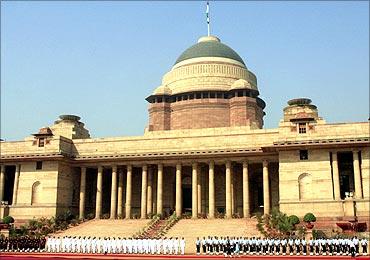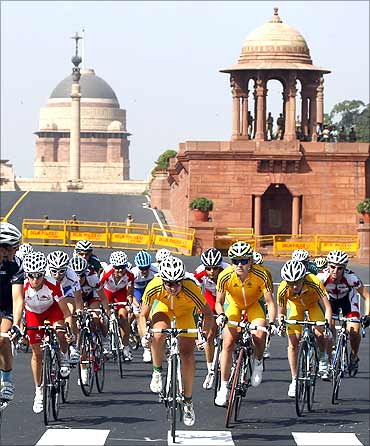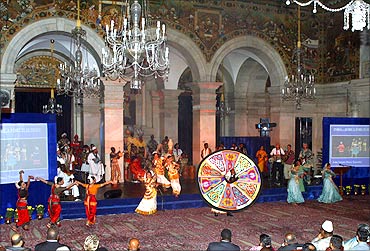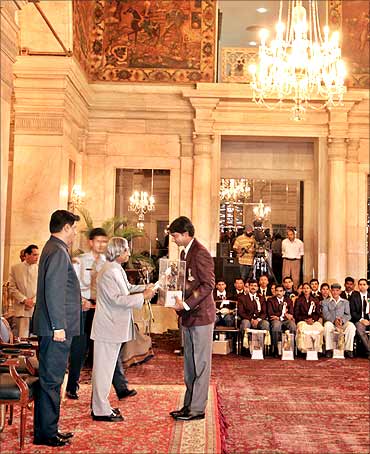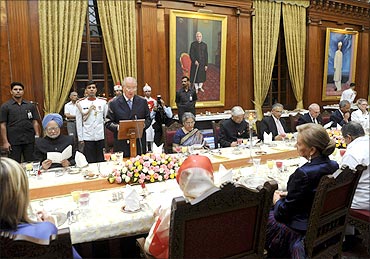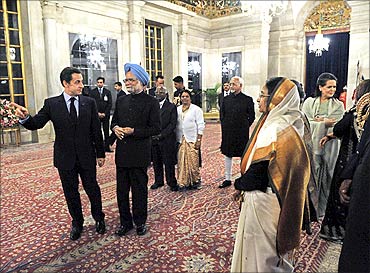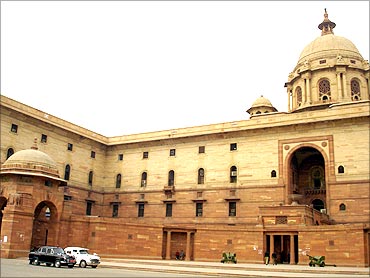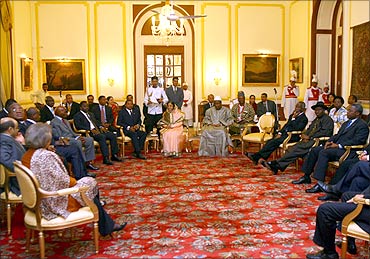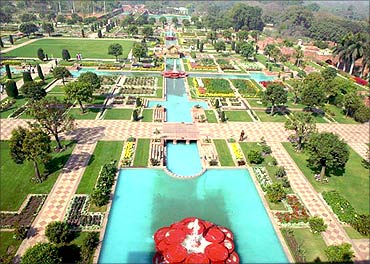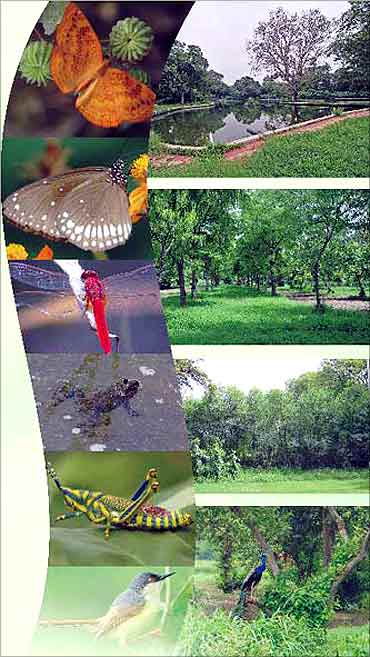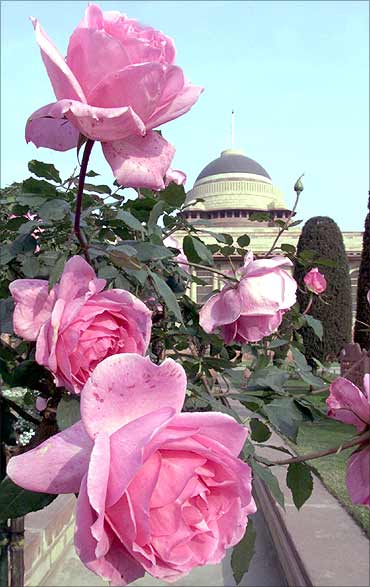This article was first published 14 years ago
India's most expensive official residence
Last updated on: May 26, 2011 10:30 IST
Image: The Indian presidential palace is illuminated during the Beating the Retreat ceremony in New Delhi.
Photographs: B Mathur/Reuters.
While millions are homeless, live in appalling conditions in India, the president lives in a palatial 340-room palace.
It is the largest residence of any chief of the state in the world.
Even as population of people in India's slums is projected to rise to 93 million in 2011 or 7.75 percent of the total population, our head of the state lives in a grand palace maintained at a cost that runs into crores.
In 2007, the maintenance cost of the presidential palace was estimated to be more than Rs 100 crore (Rs 1 billion) per year!
The electricity bill of the Rashtrapati Bhavan in 2007-2008 stood at Rs 6.30 crore (Rs 63 million) followed by Rs 6.88 crore (Rs 68.8 million) in 2008-2009 and Rs 6.67 crore (Rs 66.7 million) in 2009-2010.
Besides the Rashtrapati Bhavan at New Delhi, the President has official residences in two other states - Rashtrapati Nilayam near Secunderabad and The Retreat at Mashobra, near Shimla.
Click NEXT to find out more about India's most extravagant official residence...
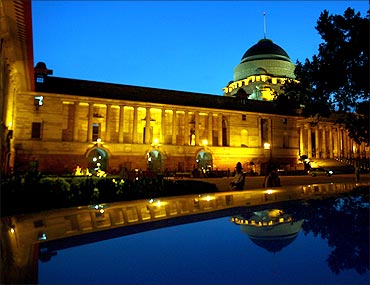
Image: A view of India's presidential palace Rashtrapati Bhavan.
Photographs: B Mathur/Reuters.
The Rashtrapati Bhavan is one India's best archiectural marvels. A magnificent four-storeyed mansion, it has a floor area of 200,000 square feet. It was built by using 700 million bricks and three million cubic feet of stone.
Image: Guards stand in the Mughal gardens surrounding Rashtrapati Bhavan.
Photographs: Reuters.
The cost of building this architectural wonder escalated to Rs 12.8 million, much higher than the projected cost.
The building along with the Mughal Garden and the staff quarters together coast a whopping Rs 14 million at that time.
At the present rates, its value would runs into thousands of crores. The building was scheduled to be completed in four years. However, it took 17 years to complete this magnificent building.
Image: Guards stand in the Mughal gardens surrounding Rashtrapati Bhavan.
Photographs: Reuters.
Edwin Lutyens was the chief architect of this impressive residence and Hugh Keeling was the chief engineer.
The most prominent and distinguishing aspect of Rashtrapati Bhavan is its dome which is superimposed on its structure.
Indian contractor Haroun-al-Rashid did most of the work of the main building and the forecourt was built by Sujan Singh and his son Sobha Singh.
Image: A ceremonial reception at Rastrapati Bhavan.
Photographs: Reuters.
The British decided to build a platial residence in New Delhi for their Viceroy. They wanted 'an empire in stone' to establish their colonial footprint in the Indian soil.
It is interesting to note that the building which was scheduled to be completed in four years took seventeen years and on the eighteenth year of its completion India became independent.
Image: Rastrapati Bhavan.
After independence when C Rajagopalachari assumed the office as the first Governor General of India, he refused to stay in the Ashoka Suite used by the Brisih Viceroy terming it as too luxurious.
He preferred to stay in one of the guestrooms. The tradition was followed by successive presidents.
Image: Indian President's Bodyguards (PBG), mounted on their horses.
Photographs: B Mathur/Reuters.
On 26 January 1950, when Dr Rajendra Prasad became the first President of India, the building was renamed, Rashtrapati Bhavan - the President's House.
Image: Indian troops from the Border Security Force (BSF) ride on camels.
Photographs: B Mathur/Reuters.
The sprawling edifice has 74 lobbies and galleries, one and a half miles of corridors, 18 staircases and 37 fountains.
The building was made with materials from India. Only the Italian marble was imported for the flooring. Steel is hardly used in the building.
Image: President Pratibha Patil waves to photographers from the famous Mughal Garden.
Photographs: Vijay Mathur/Reuters.
The luxurious apartments that were used by the British Viceroy is converted into a guest wing where the Heads of State of other countries stay during their visit to India.
Image: A ceremonial reception at the presidential palace in New Delhi.
Photographs: B Mathur/Reuters.
An interesting feature of the architecture of the Rashtrapati Bhavan is the fusion of Indian and European designs.
Temple bells, which are part of Hindu, Buddhist and Jain traditions have been perfectly blended with the Hellenic style architecture. The idea to design bells in the pillars of Rashtrapati Bhavan came from a Jain temple at Moodabidri in Karnataka.
Image: Women's road race cycling event, Rastrapati Bhavan in the background.
Photographs: Danish Ismail/Reuters.
The highlight of the building is
Chhajja. These are stone slabs which are fixed below the roof of a building and are designed for the purposes of preventing the sunrays from falling on the windows and protecting the walls from the rains.
Chhatris adorn the rooftop of the building.
Image: Rashtrapati Bhavan.
Jaalis are also of typical Indian designs, which add beauty to the architecture of the Rashtrapati Bhavan.
These are the stone slabs containing lot of perforations, designed with delicate floral and geometric patterns.
Image: Indian and African dancers perform during a cultural programme at Rashtrapati Bhavan.
Photographs: B Mathur/Reuters.
The
chhajjas, chhatris and
jaalis give building a historic look. In some of the jaalis, Lutyens used European styles to enhance their beauty and utility.
Image: Indian golfer Jyoti Randhawa receives Arjuna Award from former President Abdul Kalam.
Photographs: Kamal Kishore/Reuters.
The Durbar Hall, Ashoka Hall, Marble Hall, North Drawing Room, Nalanda Suite are famous for its aesthetics and grandeur.
The Yellow Drawing Room is used for smaller state functions like swearing-in of Comptroller and Auditor General, Chief Election Commissioner and induction of a solitary Minister in the Union Council of Ministers.
Image: Belgium's King Albert II delivers a speech before an official dinner at the Rashtrapati Bhavan.
Photographs: Reuters.
The lavish Banquet Hall can accommodate 104 persons. The Ashoka Hall gives the feel of a large jewel box. It was originally built as the State Ballroom. It has a wooden floor, a central dance space, and three vestibules.
Image: Rashtrapati Bhavan's interiors.
Unlike most halls and chambers in Rashtrapati Bhavan, the Ashoka Hall has a painted ceiling. The painting is in the Persian style.
The main painting on the roof depicts a royal hunting expedition while those towards the corners show scenes from court life.
The painting done on leather was commissioned by Lady Willingdon when her husband was the Viceroy.
Image: Rashtrapati Bhavan's grand interiors.
The North Drawing Room is used for receiving visiting heads of state.
Two striking paintings are - The Transfer of power on August 14 by S N Goshal and swearing-in ceremony of First Indian Governor General.
Image: President Pratibha Patil welcomes France's President Nicolas Sarkozy and PM Manmohan Singh.
Photographs: Eric Feferberg/Reuters.
The Rashtrapati Bhavan has a museum with autographed photographs of several heads of states.
The gifts received by the President during visits abroad or in India and from visiting heads of state at New Delhi are exhibited here.
Image: Rashtrapati Bhavan.
Leaving a trail of the imperialist past are Statues of King George V and Queen Mary, oil portraits of former viceroys and governors General, the silver chair for the Queen, the brass replica of British Crown.
Image: President Pratibha Patil (C) attends a meeting with African leaders at Rashtrapati Bhavan.
Photographs: B Mathur/Reuters.
The Durbar Hall has a 2-ton chandelier hanging from a height of 33 meters. This room was called the Throne Room during the British era.
There were 2 separate thrones for the Viceroy and Vicereine, which have now been replaced by a simple chair for the President. The hall is used for state functions.
Image: Mughal Gardens.
The Mughal Gardens spread across 13 acres is a blend of Mughal and British styles. The Mughal Gardens are open to the public in February-March every year.
Image: Rashtrapati Bhavan surrounded by beautiful garden.
Photographs: Reuters.
Two channels running north to south and two running east to west divide this garden into a grid of squares.
Image: Nature at its best.
There are six lotus shaped fountains. The fountains add to the beauty of the tranquil surroundings, rising up to a height of 12 feet.
A nature trail has been developed in the President's Estate to create awareness about the environment. The trail is open for visitors on Saturdays.
Image: Roses bloom in Mughal Gardens.
Photographs: Reuters.
The garden has a variety of exotic flowers and roses. The Rashtrapati Bhavan also has nine tennis courts, a polo ground, a 14-hole golf course and a cricket field.


